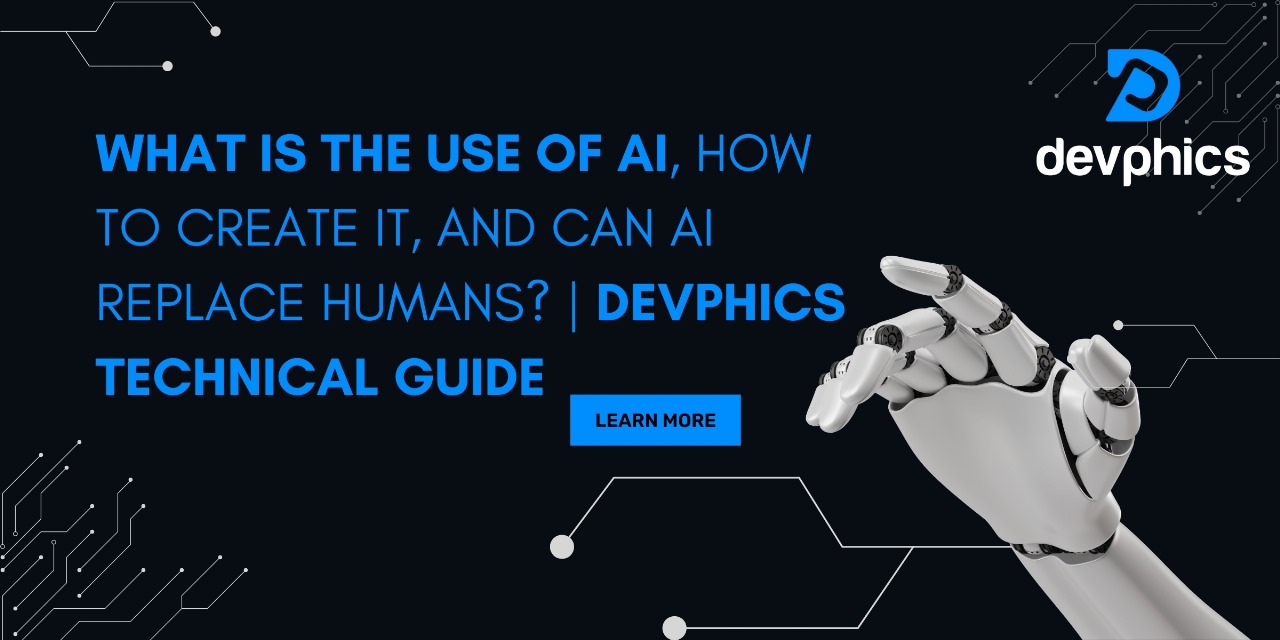
What is the Use of AI, How to Create It, and Can AI Replace Humans?
- AI, Tech, World Today
- September 25, 2025
- 8:30 am
- info@devphics.com
🧠 What is Artificial Intelligence (AI)?
Artificial Intelligence (AI) refers to systems or software that perform tasks normally requiring human intelligence. This includes:- Pattern recognition
- Natural language understanding
- Prediction from data
- Generation of content (text, image, code)
✅ What Are the Uses of AI?
Some of the primary applications in software and digital product domains:| Domain | Use Case | Benefits |
|---|---|---|
| Automation & Productivity | Automate data entry, content tagging, customer support systems, etc. | Free up human time, reduce error, scale faster |
| Personalization | Recommendation engines, adaptive interfaces | Better user retention, higher conversions |
| Computer Vision | Image classification, object detection (e.g., for security, medical imaging) | Enables new features, automates visual tasks |
| Natural Language Processing (NLP) | Chatbots, sentiment analysis, summarization | Improves UX, supports content generation |
| Generative AI | Auto-designs, content generation, rapid prototyping | Speeds up creative workflows, allows more iteration |
🛠️ How to Create AI: Technical Workflow + Code Example
Here’s a more developer-centric look at how to build an AI model end-to-end, plus a simple code example using Python (Scikit-Learn) to put things into practice.Technical Workflow
- Define the Problem
- Classification vs Regression
- Supervised vs Unsupervised vs Reinforcement Learning
- Data Collection & Preprocessing
- Gather labeled / unlabeled data
- Clean data (handle missing values, outliers)
- Feature selection or extraction
- Normalize / standardize data
- Model Selection
- Classical Machine Learning (e.g. logistic regression, random forest, SVM)
- Deep Learning (CNNs, RNNs, Transformers) depending on the data type
- Training & Evaluation
- Split into train / validation / test sets
- Hyperparameter tuning (grid search, random search)
- Use metrics appropriate to the task (accuracy, precision, recall, AUC, etc.)
- Deployment
- Wrap model in an API (Flask, FastAPI)
- Containerize (Docker) for portability
- Host on cloud service / on-premises environment
- Monitor performance over time (data drift, model retraining)
Code Example: Simple Regression Model in Python
Here’s a basic example showing how one might build a linear regression model in Python using Scikit-Learn. Useful for numerical prediction tasks (e.g., forecasting sales, estimating prices).import numpy as np
import pandas as pd
from sklearn.model_selection import train_test_split
from sklearn.linear_model import LinearRegression
from sklearn.metrics import mean_squared_error, r2_score
# Load data (replace 'data.csv' with your dataset)
data = pd.read_csv('data.csv')
# Suppose data has features: 'feature1', 'feature2', … and target: 'target'
X = data[['feature1', 'feature2', 'feature3']]
y = data['target']
# Split data into training and testing
X_train, X_test, y_train, y_test = train_test_split(
X, y, test_size=0.2, random_state=42
)
# Create and train the model
model = LinearRegression()
model.fit(X_train, y_train)
# Predict on test set
y_pred = model.predict(X_test)
# Evaluate performance
mse = mean_squared_error(y_test, y_pred)
r2 = r2_score(y_test, y_pred)
print(f"Mean Squared Error: {mse:.4f}")
print(f"R² Score: {r2:.4f}")- Try more complex models, e.g. decision trees, random forests, or neural networks.
- Add cross-validation.
- Feature engineering.
- Scaling up with larger datasets and deeper architectures.
🤖 Can AI Replace Humans?
Here’s a technical take on what AI can and cannot do when compared to humans in professional/creative/operational roles:| Capability | AI Strengths | AI Limitations / What Humans Still Do Better |
|---|---|---|
| Repetitive / High-Volume Tasks | Excellent (automation, scalability) | Humans required for oversight, nuance |
| Data-Driven Prediction | Can sift huge datasets and spot patterns | Weak when context, ethics, unusual conditions matter |
| Creativity / Strategy / Ethics | Generative AI helps, but within constraints | Humans excel in strategy, vision, moral reasoning, abstract thinking |
| Emotional Intelligence & Social Interaction | Basic sentiment analysis, chatbots | Deep empathy, negotiation, trust-building are human domains |
🔗 Devphics Services & Internal Links
To apply AI tech in real products, here are Devphics services that align well:- Website Development — integrating AI-powered features into websites: chatbots, personalization, recommendation systems.
- Mobile App Development — adding on-device AI, gesture recognition, voice interfaces.
- Digital Marketing — AI-based analytics, predictive customer segmentation.
- SEO — using AI tools for keyword research, content optimization.
- UI / UX Design — AI-assisted prototyping, behavior prediction.
📸 Featured Image / Diagram Concept
To make the blog visually strong, here are some suggestions:- Featured Image: A clean graphic showing “Human + AI collaborating” — maybe half the image is a human hand, half is digital / circuit / robotic style, or showing AI workflow.
- Diagram: An “AI Development Pipeline” illustration:
- Data Collection →
- Preprocessing →
- Model Training →
- Evaluation →
- Deployment →
- Monitoring & Retraining.
🔗 Social Media Captions
Here are a few caption options to promote this post on platforms like LinkedIn, Twitter, Instagram, etc.:- “What CAN’T AI do? Explore what it can — how to build AI, what it’s really useful for, and whether it might replace humans. Technical guide now up on Devphics! 🚀 #AI #MachineLearning #Devphics”
- “Devphics dives deep: from code to deployment, learn how AI is created, where it excels, and what human qualities it still can’t mimic. Read the full technical guide. #ArtificialIntelligence #TechBlog #AIUsage”
- “AI isn’t about replacement — it’s about collaboration. We’ve broken down how AI works, how to build it, and which human-skills stay essential. Check out our latest on Devphics. #DeepLearning #NLP #UX”
- “Building AI from scratch? We got you. From data pipelines to deployment and beyond, discover the full roadmap with real code examples in our new Devphics blog post. #Python #AI #Devphics”
